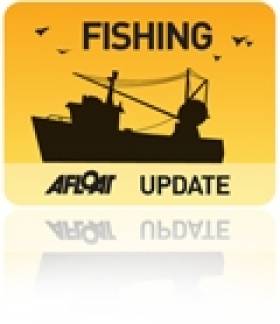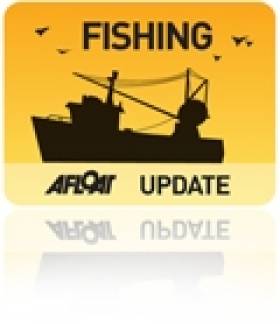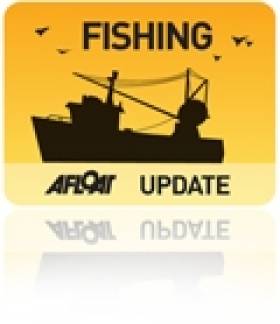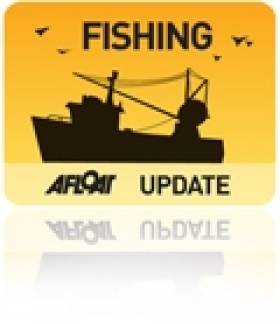Displaying items by tag: Fishing
#Aquaculture - Marine Minister Simon Coveney yesterday (12 June) launched a public consultation on a draft National Strategic Plan for Sustainable Aquaculture Development, proposing 24 actions and initiatives to boost the sustainable growth of aquaculture.
The reformed Common Fisheries Policy requires EU member states to prepare multi-annual national strategic plans to drive forward the sustainable development of aquaculture, and the draft plan launched this week has been prepared in that context.
Commenting on the plan, Minister Coveney said: “Aquaculture is a rapidly growing industry internationally with very rapid expansion opportunities identified over the coming decades to meet the ever growing seafood demand arising from population growth and increased consumption in Asia.
"Aquaculture internationally produced 67 million tonnes of farmed fish in 2012 and it is projected to increase to 85 million tonnes by 2022. That global projection to increase aquaculture production by 18 million tonnes by 2022, puts in context the proposals in the National Strategic Aquaculture Plan to increase Irish aquaculture production by 45,000 tonnes, across all species, by 2023.
"While the targets in the plan are ambitious in the context of the past performance of this industry nationally, they are modest in the context of the global expansion which this industry will experience over the next seven years.”
Minister Coveney added that “our aquaculture industry has long been recognised as an area with potential to grow significant value and employment and to sustainably provide the raw material to enhance our processed seafood exports. Clearly, that has not happened and there are many complex reasons for that.
"At the same time, concerns have been raised about the environmental sustainability of the industry. In this plan, I have sought to identify all of the issues affecting both the growth potential and sustainability of the aquaculture industry and I am proposing a suite of 24 tailored actions to boost sustainable growth, while allaying legitimate areas of concern.
"With these initiatives, I believe we can get our aquaculture sector back on a path of sustainable growth and provide much needed jobs in our coastal communities."
Actions proposed in the draft plan include the introduction of a set of guiding principles for the sustainable development of aquaculture, recommended to the minister by the Marine Institute, together with scale limits and phasing in relation to the development of individual offshore salmon farms, also recommended by the Marine Institute.
Other initiatives include a review of the regulatory framework for aquaculture licensing and associated administrative procedures, and financial supports to build capacity, foster knowledge, innovation and technology transfer and expert advice and training for aquaculture operators in business planning, disease management and environmental best practice.
Submissions on the draft plan and related environmental report and appropriate assessment are invited by 24 July 2015 to [email protected]. Relevant documents are available for download HERE.
#RNLI - Wicklow RNLI assisted two fishermen on a six-metre fishing boat in difficulties off Kiloughter beach on Friday morning (5 June).
The lifeboat, with three volunteer crew, launched at 8.55am following a report that the boat had a rope caught in its propeller.
After locating the fishing vessel drifting four miles north of Wicklow Harbour, they managed to free the rope from the propeller allowing the fishermen to get underway and resume fishing.
The lifeboat crew returned to station once the Irish Coast Guard was satisfied the fishing vessel required no further assistance.
The crew on this callout were helm Graham Fitzgerald, Alan Goucher and Terry Sillery.
Body Of Spanish Fisherman Recovered Off Donegal
#Fishing - The Irish Times reports that a post-mortem will be conducted on the remains of a Spanish fisherman found off the Donegal coast early yesterday (Monday 1 June).
According to The Nationalist, the man was believed to have gone overboard from the Spanish fishing trawler on which he was working on Sunday night.
The body of the 56-year-old was recovered from Killybegs Harbour around lunchtime yesterday after a widespread search by local lifeboats and coastguard, and removed to Letterkenny General Hospital.
Skipper Seeks Costs Over Fishing Offence Aquittals
#Fishing - After two lengthy trials – and two acquittals – a trawler skipper from the Aran Islands accused of breaching fishing regulations is seeking costs against the State, as The Irish Times reports.
Inis Mór fisherman John Conneely was twice taken to Galway Circuit Criminal Court this year over two separate alleged incidences of incorrect log entries for his monkfish catch on dates in 2006.
In the first trial in January, the jury found Conneely not guilty of one breach of EU fishing regulations relating to the strictly quota-managed species – a victim of the widely criticised discards policy.
The second trial last week, over similar alleged offences, saw Judge Rory McCabe direct the jury to find Conneely not guilty of a charge relating to keeping more monkfish on board than allowed by quota.
The Irish Times has more on the story HERE.
#Fishing - Marine Minister Simon Coveney announced on Tuesday (26 May) the introduction of national management measures for razor clams.
The minister brought forward the proposals at the third National Inshore Fisheries Forum (NIFF) meeting, where he announced the introduction of an outtake limit for fishing razor clams in the North Irish Sea of 700kg per vessel per week to take effect from Monday 1 June 2015.
Speaking about the new measures, Minister Coveney said: “At the second NIFF meeting in April, I stated that I would take steps to secure the sustainability of the razor clam fishery, and the new interim measures for the North Irish Sea are a first step in that process.
"I am also conscious that certainty about safe, high quality Irish seafood is important for consumers and for the marketplace. Accordingly, I have decided to introduce national measures to ensure Ireland can demonstrate its commitment to safe seafood.”
The new national measures include:
- Obligations to weigh and report all razor clam landings,
- A requirement to ensure fishing takes place only in shellfish production areas which have been classified for razor clams
- A requirement to fish in only one class of shellfish production area, from a seafood safety perspective, per day, and
- An obligation for vessels in Irish waters to carry GPS tracking equipment from 20 July.
The protection of Natura 2000 sites also featured on the agenda at Tuesday’s meeting, and the minister welcomed support from the NIFF to facilitate stakeholder engagement in preparing mitigation plans for sites with features at risk from certain fishing activities.
“There are features in a number of Natura 2000 sites which are particularly sensitive to certain fishing activities, and we must ensure that the integrity of these Special Areas of Conservation is protected," the minister said.
"Protecting the ecosystems of marine conservation sites preserves the quality of our marine environment and is another step towards harnessing our ocean wealth in a sustainable way.”
The NIFF has been set up to encourage inshore fishing communities to discuss their fishing issues and generate commonly-supported initiatives. Ciaran Quinn of the North West region is the first industry-led chair of the forum, and Eddie Moore of the South West region is the vice chair.
Lobster conservation measures and proposals to manage recreational pot fishing were among the other inshore policy issues discussed by the NIFF members at this week’s meeting.
Invitation To Tender For Boarfish Survey Vessel Charter
#Fishing - The Marine Institute is inviting tenders for the supply of a commercial fishing vessel to conduct a boarfish acoustic survey in ICES divisions VII b, c, g, h, j & k (west of Ireland, Celtic Sea and northern Biscay).
The vessel would be chartered for a period of 21 days to survey spawning aggregations of boarfish – a big seller for Ireland in the Chinese market – using hydro-acoustic techniques.
Vessels are invited to tender on the basis of their ability to undertake the survey schedule. This comprises following a pre-determined cruise track in the order of 3,200 nautical miles carried out over 21 days with 20hr operations (4am-midnight) and with directed trawl stations on fish schools of interest as and when required.
A single pelagic midwater trawl with a vertical opening of greater than 40m and contain a 20mm codend liner and/or sprat brailer will be a requirement for the survey. A liner can be provided if required but all other associated fishing equipment must be provided by the vessel.
The survey will be timed to coincide with the southerly end point of the RV Celtic Explorer on 10 July 2015 and this survey will act as a continuation. It is therefore essential that the charter vessel is out on the water and ready to begin surveying no later than midnight on 9 July 2015.
Detailed information of the track and survey plan will be provided by the Marine Institute. The successful applicant will be selected based on technical suitability, cost of charter, pelagic fishing track record and previous experience in scientific research and surveys.
The closing date for tenders is this Friday 29 May 2015 at 12 noon. Full details of the tender are available in a PDF to read or download HERE.
Campaign Against Galway Bay Fish Farm Blasts PR Spend
#FishFarm - Bórd Iascaigh Mhara (BIM) has been blasted by campaigners against its proposed Galway Bay salmon farm for spending tens of thousands of euro on PR for the controversial project.
According to the Connacht Tribune, Galway Bay Against Salmon Cages described as "worrying" the more than €57,000 paid to PR firm Keating & Associates for "communications service", just one of various spends on private consultants totalling more than half a million euro.
The group also expressed concern over letter sent on behalf of BIM to the editors of national newspapers, citing them as an effort to "stifle debate".
However, BIM says the letters were issued "in order to address the publication of inaccuracies regarding BIM and the Galway Bay application".
It also defended the expenditure on consultants as normal operating costs, claiming it regularly hires outside expertise when needed.
Local groups opposed to the 500-hectare salmon farm off the Aran Islands – which would be largest aquaculture project of its kind in Europe – continue to wait for Marine Minister Simon Coveney to make a decision on BIM's licence application, which was originally promised before this summer.
The Connacht Tribune has more on the story HERE.
#MarineNotice - Marine Notice No 8 of 2005 supplemented by Marine Notice No 16 of 2011 provided information on eight types of liferaft, which the Department of Transport, Tourism and Sport (DTTAS) accepts for use on small fishing vessels that are not required to carry a SOLAS/MED-approved liferaft.
The department now advises, in Marine Notice No 20 of 2015, that an additional liferaft has been deemed acceptable for use on such vessels. For clarity, the complete list – including the additional liferaft type now added – is shown below.
Accepted non-SOLAS/non-MED inflatable liferafts:
- DSB 4 - Person Inflatable Liferaft with “SOLAS B Pack”
- RFD Surviva 4 - Person Inflatable Liferaft with “SOLAS B Pack”
- RFD SEASAVA PRO ISO 9650 4 - Person Inflatable Liferaft with “SOLAS B Pack”
- Viking DK 4 - Person Inflatable Liferaft with “SOLAS B Pack”
- Zodiac 4 - Person Inflatable Liferaft with “SOLAS B Pack”
- EUROVINIL ISO/DIS 9650 4 - Person Inflatable Liferaft with “SOLAS B Pack”
- Sea-Safe 4 person inflatable liferaft :ISO 9650.1 group A Type 1 with “SOLAS B pack”
- Seago - ISO 9650-1 SOLAS B pack – 4 PERSON Liferaft
- Haining, Liferaft model HNF-YT IS09650-1 – with SOLAS B pack
#Fishing - Marine Minister Simon Coveney today (Wednesday 20 May) welcomed an EU Commission proposal for a comprehensive prohibition on commercial fishing for seabass in the Irish and Celtic Seas which underpins the conservation actions already taken by Ireland with regard to this vulnerable stock.
“Ireland has had stringent measures in place for the protection of seabass, a very important angling species, for a long number of years. However, those measures only applied to Irish vessels," said the minister.
"I have been very active over the past six months, lobbying the EU Commission and relevant member states on this issue. I am delighted that the EU finally recognises the lead taken by Ireland by extending our ban on commercial fishing to all EU vessels operating in the waters around Ireland.”
Minister Coveney added: “The scientific advice for seabass is very worrying and we must all do our utmost to protect this stock. Ireland has been to the forefront in being the only EU member state to afford maximum protection to this stock and today’s proposal will enhance that protection by making the Irish model obligatory for all EU vessels in the Irish & Celtic Seas.”
Once the measures are approved by the Council of Ministers, all commercial fishing for seabass will be prohibited in the waters around Ireland. Details of the prohibition areas are included HERE.
#LoughNeagh - Families who have worked for generations in eel farming on Lough Neagh - putting the region on the map for its world-renowned eels – fear they are being pushed out of the industry by "unfair" policies, say campaigners.
And as Belfast Live reports, the authorities in charge of eel permits have also been accused of refusing to renew existing licences.
The Lough Neagh United Fishermen, or LNUF, says many long-time eel fishing families "grew up with the assurance that [they] would be 'looked after'".
Spokesperson Brian Wylie says his group's members also hold shares in the Lough Neagh Fishermen's Co-operative Society Ltd, which is authorised to issue permits for eel fishing.
"Our members are being ignored [by the co-operative] on a yearly basis, and can clearly see permits being handed out to people and their families never were involved in the ethos or concept," he adds.
Belfast Live has more on the story HERE.





































































